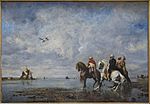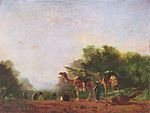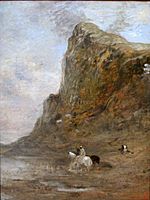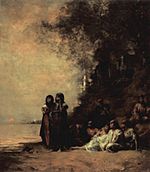Eugène Fromentin facts for kids
Quick facts for kids
Eugène Fromentin
|
|
|---|---|
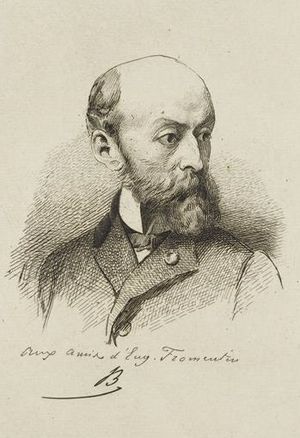 |
|
| Born | 24 October 1820 |
| Died | 27 August 1876 (aged 55) La Rochelle
|
| Nationality | French |
| Education | Louis Cabat |
| Known for | Painter, Author |
| Movement | Orientalist |
Eugène Fromentin (born October 24, 1820 – died August 27, 1876) was a talented French artist. He was known for both his paintings and his writing. Today, many people remember him more for his books.
Contents
Life of a Talented Artist
Eugène Fromentin was born in a city called La Rochelle in France. After finishing school, he studied painting for several years. His teacher was a landscape painter named Louis-Nicolas Cabat.
Exploring New Lands
Fromentin was one of the first artists to paint scenes from Algeria. When he was young, he visited this country in North Africa. He loved the land and its people. His trips helped him fill his memory and his sketchbooks with many interesting details. These details later became the subjects of most of his paintings. In 1849, he won a special award called a "medal of the second class" for his art.
In 1852, Fromentin went back to Algeria. This time, he joined a group exploring old historical sites. He spent a lot of time carefully studying the landscapes and the daily lives of the people. This close study helped him make his later artworks very realistic. They showed what he had learned from his deep understanding of Algeria.
A Painter and a Writer
Eugène Fromentin was special because he was good at two things: painting and writing. His paintings often showed scenes from North Africa. He was part of an art movement called Orientalism. This style focused on the cultures of the Middle East and North Africa.
Famous Paintings
Fromentin's first big success was a painting called Gorges de la Chiffa. He showed it at the Paris Salon in 1847. The Salon was a very important art show in Paris. Here are some of his other important paintings:
- La Place de la Brèche à Constantine (1849)
- Enterrement Maure (1853)
- Bateleurs nègres (1859)
- Audience chez un chalife (1859)
- Berger kabyle (1859)
- Courriers arabes (1861)
- Bivouac arabe (1863)
- Chasse au faucon (1863)
- Fauconnier arabe (1863)
- Chasse au héron (1865)
- Voleurs de nuit (1867)
- Centaures et arabes attaqués par une lionne (1868)
- Halte de muletiers (1869)
- Le Nil (1875)
- Un souvenir d'Esneh (1875)
Important Books
Fromentin also wrote several books. One of his most famous is Les Maîtres d'autrefois (which means "The Masters of Past Time"). This book came out in 1876. In it, he wrote about famous old painters from Belgium and Holland. He discussed artists like Rubens and Rembrandt. He looked at their painting styles and the feelings the artists had when they created their works.
Fromentin was one of the first "art critics" to write about old master paintings from a personal view. He was a painter himself, so he understood the art deeply. He also explained how the art fit into the social, political, and economic times. For example, he wrote about how Dutch Golden Age painting grew after Holland became independent. This book started as articles he wrote for magazines.
Another important book he wrote was Dominique. This story was first published in a magazine in 1862. It is known for its careful observations and strong emotions. He also wrote A Summer in the Sahara, which shared his experiences in North Africa.
His Unique Art Style
Fromentin believed that "art is the expression of the invisible by means of the visible." This means he thought art could show hidden feelings or ideas through what you could see. He was greatly influenced by another famous painter, Eugène Delacroix.
Fromentin's paintings are known for their strong designs and bright colors. He was very skilled at painting. His works showed the natural grace of people and animals from North Africa. However, some of his later paintings showed less energy, perhaps because he was getting weaker.
Even though he was a great painter, many people think his writing was even more special. Besides the books mentioned, he also wrote: Visites artistiques (1852), Simples Pèlerinages (1856), Un été dans le Sahara (1857), and Une année dans le Sahel (1858). He tried to join the French Academy in 1876 but was not chosen. He passed away suddenly in La Rochelle on August 27, 1876.
Images for kids
- Selection of works
See also
 In Spanish: Eugène Fromentin para niños
In Spanish: Eugène Fromentin para niños
- List of Orientalist artists
- Orientalism


